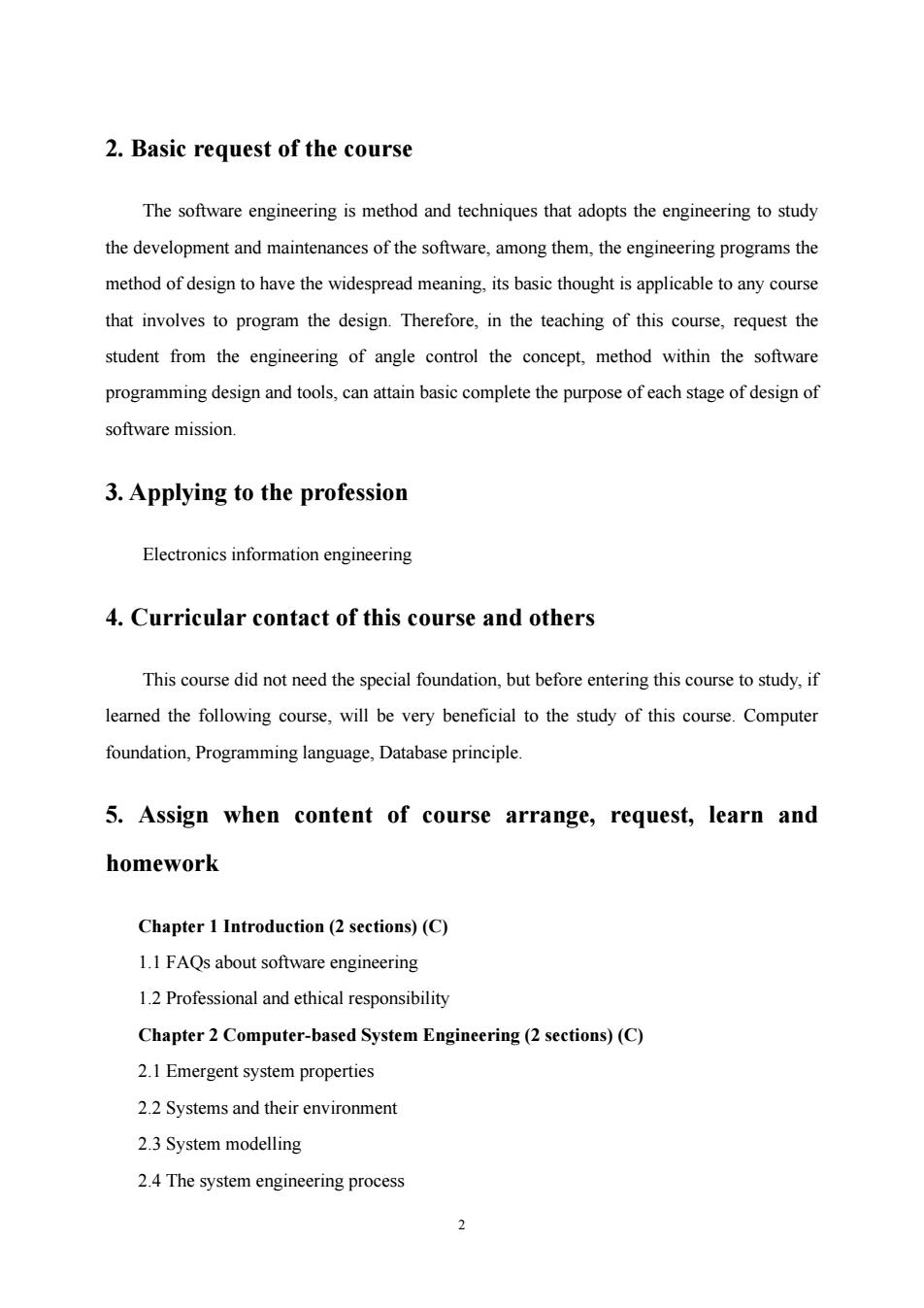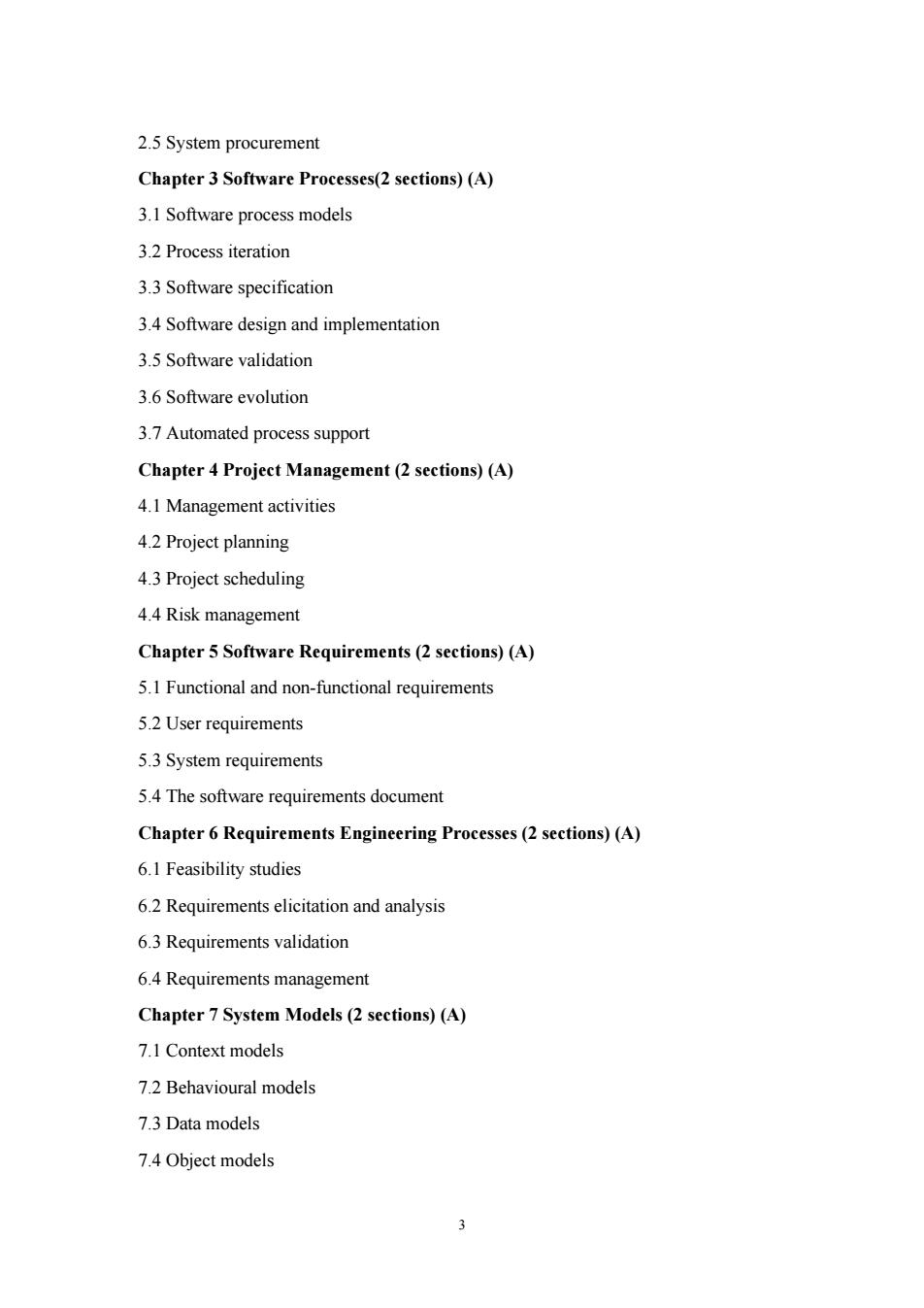
GD0U-B-11-213 《软件工程导论》教学大纲 Software Engineering Syllabus 课程编号1610043总学时36理论36实验/上机0 学分2开课单位信息学院开课系电子工程系修订时间2006年1月1日 Course Introduction Content of course The software engineering is the method,tool that the method and techniques of the applied engineering study the software development and maintenances and a calculator science and engineering of managements to learn the cross course.This course contents divides two parts.the first part according to the software life cycle of in proper order introduce the mission. process,structure of each stage to turn the method and tools;The second part relates the system analysis and the design methods of face to the objects. Study the profession:The electronics information engineering Take the course first:The computer foundation,Programming language.Database principle Textbook:Software Engineering(6h Edition),lan Sommerville,CHINA Machine Press. 1.The property and the mission of the course This course is the technique foundation course of the electronics information engineering profession.Pass the study of this course,make relation between explicit software system Chinese file and the procedure code of student,control basic method and technical abilities of the software design. The mission of this course lies in the engineering thought that make student set up the software design,having the understanding of a system for the principle and methods of the software engineering.the importance of the explicit software engineering Chinese file.to complete the mission of each stage of life cycle of software to beat certain foundation. 1
GDOU-B-11-213 《软件工程导论》教学大纲 Software Engineering Syllabus 课程编号 1610043 总学时 36 理论 36 实验/上机 0 学分 2 开课单位 信息学院 开课系 电子工程系 修订时间 2006 年 1 月 1 日 Course Introduction Content of course The software engineering is the method, tool that the method and techniques of the applied engineering study the software development and maintenances and a calculator science and engineering of managements to learn the cross course. This course contents divides two parts, the first part according to the software life cycle of in proper order introduce the mission, process, structure of each stage to turn the method and tools; The second part relates the system analysis and the design methods of face to the objects. Study the profession: The electronics information engineering Take the course first: The computer foundation, Programming language, Database principle Textbook: Software Engineering (6th Edition), Ian Sommerville, CHINA Machine Press. 1. The property and the mission of the course This course is the technique foundation course of the electronics information engineering profession. Pass the study of this course, make relation between explicit software system Chinese file and the procedure code of student, control basic method and technical abilities of the software design. The mission of this course lies in the engineering thought that make student set up the software design, having the understanding of a system for the principle and methods of the software engineering, the importance of the explicit software engineering Chinese file, to complete the mission of each stage of life cycle of software to beat certain foundation. 1

2.Basic request of the course The software engineering is method and techniques that adopts the engineering to study the development and maintenances of the software.among them.the engineering programs the method of design to have the widespread meaning.its basic thought is applicable to any course that involves to program the design.Therefore.in the teaching of this course,request the student from the engineering of angle control the concept,method within the software programming design and tools,can attain basic complete the purpose of each stage of design of software mission. 3.Applying to the profession Electronics information engineering 4.Curricular contact of this course and others This course did not need the special foundation,but before entering this course to study,if learned the following course,will be very beneficial to the study of this course.Computer foundation,Programming language,Database principle. 5.Assign when content of course arrange,request,learn and homework Chapter 1 Introduction(2 sections)(C) 1.1 FAQs about software engineering 1.2 Professional and ethical responsibility Chapter 2 Computer-based System Engineering(2 sections)(C) 2.1 Emergent system properties 2.2Systems and their environment 2.3 System modelling 2.4The system engineering process 2
2. Basic request of the course The software engineering is method and techniques that adopts the engineering to study the development and maintenances of the software, among them, the engineering programs the method of design to have the widespread meaning, its basic thought is applicable to any course that involves to program the design. Therefore, in the teaching of this course, request the student from the engineering of angle control the concept, method within the software programming design and tools, can attain basic complete the purpose of each stage of design of software mission. 3. Applying to the profession Electronics information engineering 4. Curricular contact of this course and others This course did not need the special foundation, but before entering this course to study, if learned the following course, will be very beneficial to the study of this course. Computer foundation, Programming language, Database principle. 5. Assign when content of course arrange, request, learn and homework Chapter 1 Introduction (2 sections) (C) 1.1 FAQs about software engineering 1.2 Professional and ethical responsibility Chapter 2 Computer-based System Engineering (2 sections) (C) 2.1 Emergent system properties 2.2 Systems and their environment 2.3 System modelling 2.4 The system engineering process 2

2.5 System procurement Chapter 3 Software Processes(2 sections)(A) 3.1 Software process models 3.2 Process iteration 3.3 Software specification 3.4 Software design and implementation 3.5 Software validation 3.6 Software evolution 3.7 Automated process support Chapter 4 Project Management(2 sections)(A) 4.1 Management activities 4.2 Project planning 4.3 Project scheduling 4.4 Risk management Chapter 5 Software Requirements(2 sections)(A) 5.1 Functional and non-functional requirements 5.2 User requirements 5.3 System requirements 5.4The software requirements document Chapter 6 Requirements Engineering Processes(2 sections)(A) 6.1 Feasibility studies 6.2 Requirements elicitation and analysis 6.3 Requirements validation 6.4 Requirements management Chapter 7 System Models(2 sections)(A) 7.1Context models 7.2 Behavioural models 7.3 Data models 7.4Object models
2.5 System procurement Chapter 3 Software Processes(2 sections) (A) 3.1 Software process models 3.2 Process iteration 3.3 Software specification 3.4 Software design and implementation 3.5 Software validation 3.6 Software evolution 3.7 Automated process support Chapter 4 Project Management (2 sections) (A) 4.1 Management activities 4.2 Project planning 4.3 Project scheduling 4.4 Risk management Chapter 5 Software Requirements (2 sections) (A) 5.1 Functional and non-functional requirements 5.2 User requirements 5.3 System requirements 5.4 The software requirements document Chapter 6 Requirements Engineering Processes (2 sections) (A) 6.1 Feasibility studies 6.2 Requirements elicitation and analysis 6.3 Requirements validation 6.4 Requirements management Chapter 7 System Models (2 sections) (A) 7.1 Context models 7.2 Behavioural models 7.3 Data models 7.4 Object models 3

7.5 CASE workbenches Chapter 8 Software Prototyping(2 sections)(B) 8.1 Prototyping in the software process 8.2 Rapid prototyping techniques 8.3 User interface prototyping Chapter 10 Architectural Design(2 sections)(A) 10.1 System structuring 10.2 Control models 10.3 Modular decomposition 10.4 Domain-specific architectures Chapter 11 Distributed Systems Architectures(2 sections)(C) 11.1 Multiprocessor architectures 11.2 Client-server architectures 11.3 Distributed object architectures 11.4 CORBA Chapter 15 User Interface Design(2 sections)(A) 15.1 User interface design principles 15.2 User interaction 15.3 Information presentation 15.4 User support 15.5 Interface evaluation Chapter 16 Dependability(2 sections)(C) 16.1 Critical systems 16.2 Availability and reliability 16.3 Safety 16.4 Security Chapter 19 Verification and Validation(1 sections)(A) 19.1 Verification and validation planning 19.2 Software inspections
7.5 CASE workbenches Chapter 8 Software Prototyping (2 sections) (B) 8.1 Prototyping in the software process 8.2 Rapid prototyping techniques 8.3 User interface prototyping Chapter 10 Architectural Design (2 sections) (A) 10.1 System structuring 10.2 Control models 10.3 Modular decomposition 10.4 Domain-specific architectures Chapter 11 Distributed Systems Architectures (2 sections) (C) 11.1 Multiprocessor architectures 11.2 Client-server architectures 11.3 Distributed object architectures 11.4 CORBA Chapter 15 User Interface Design (2 sections) (A) 15.1 User interface design principles 15.2 User interaction 15.3 Information presentation 15.4 User support 15.5 Interface evaluation Chapter 16 Dependability (2 sections) (C) 16.1 Critical systems 16.2 Availability and reliability 16.3 Safety 16.4 Security Chapter 19 Verification and Validation (1 sections) (A) 19.1 Verification and validation planning 19.2 Software inspections 4

19.3 Automated static analysis 19.4 Cleanroom software development Chapter 20 Software Testing(2 sections)(A) 20.1 Defect testing 20.2 Integration testing 20.3Object-oriented testing 20.4Testing workbenches 6.Experiment the contents and requests None 7.Textbook and reference book 7.1 Textbook: Software Engineering(6h Edition),Ian Sommerville,CHINA Machine Press. 7.2 Reference book: 1.《软件工程导论》(第三版)张海藩编著清华大学出版社1998年1月 2.《软件工程方法学及应用》汤庸编著中国三峡出版社1998年1月 Written by:Alexander WANG 1tJUN.2006 电子技术与计算机软件类课程组 张楚芳 王立臣 柯文彬 王骥 王震字 徐国宝 张世龙
19.3 Automated static analysis 19.4 Cleanroom software development Chapter 20 Software Testing (2 sections) (A) 20.1 Defect testing 20.2 Integration testing 20.3 Object-oriented testing 20.4 Testing workbenches 6. Experiment the contents and requests None 7. Textbook and reference book 7.1 Textbook: Software Engineering (6th Edition), Ian Sommerville, CHINA Machine Press. 7.2 Reference book: 1. 《软件工程导论》(第三版) 张海藩编著 清华大学出版社 1998 年 1 月 2. 《软件工程方法学及应用》 汤庸编著 中国三峡出版社 1998 年 1 月 Written by: Alexander WANG. 1st JUN. 2006 5 电子技术与计算机软件类课程组 张楚芳 王立臣 柯文彬 王骥 王震宇 徐国宝 张世龙